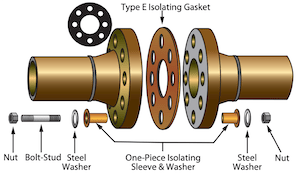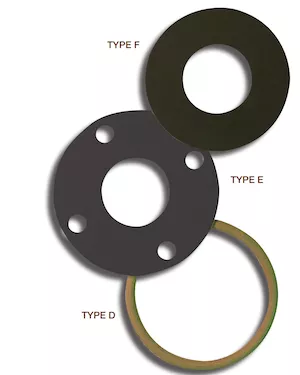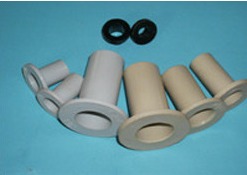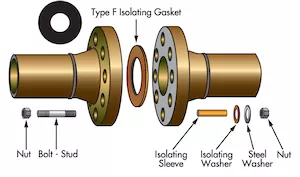A flange isolation kit protects a flanged joint from corrosion from static currents (by preventing metal-to-metal contact among flanges, stud bolts, and gaskets). A flange insulation kit consists of one washer for each nut, one full-length insulating sleeve for each bolt, a gasket (type F, E, D, O), and thick-plated steel washers for each nut.
FLANGE ISOLATION KIT
DEFINITION
A flange isolation kit is a collection of components used in piping systems to prevent galvanic corrosion and electrically isolate pipe sections. These kits are crucial in managing the integrity and extending the lifespan of pipelines, especially where dissimilar metals are connected or in environments prone to corrosive elements. By interrupting the electrical continuity of the system, these kits protect against the electrochemical reactions that can lead to corrosion and ultimately, system failure.
Components of a Flange Isolation Kit:
Insulating Gaskets: Made from materials that do not conduct electricity, such as neoprene, PTFE, or other specialized polymers. These gaskets are placed between flanges to ensure that there is no metal-to-metal contact, preventing the flow of electrical current.
Insulating Sleeves: Inserted into the bolt holes to isolate the bolts from the flanges. These sleeves are typically made from materials like polyethylene, polypropylene, or PTFE.
Insulating Washers: Positioned under the bolt heads and nuts to provide a complete electrical insulation barrier. They prevent metal-to-metal contact and are usually made from the same materials as the insulating sleeves.
Steel Washers: Often used in conjunction with insulating washers to provide mechanical strength and ensure the load is evenly distributed across the insulating washer, preventing it from being crushed when the bolt is tightened.
Applications:
Corrosive Environments: In settings where pipelines are exposed to corrosive substances, such as in chemical processing plants or offshore platforms, flange isolation kits are used to protect against corrosion that can result from electrochemical reactions.
Preventing Galvanic Corrosion: Particularly useful where dissimilar metals are joined in the piping system. Galvanic corrosion occurs when two different metals create an electrical couple in the presence of an electrolyte, leading to accelerated corrosion of the more anodic material.
Cathodic Protection Systems: In pipelines where cathodic protection is used to mitigate corrosion, flange isolation kits are essential for ensuring the effectiveness of the protection system by isolating sections of the pipeline.
Benefits:
Corrosion Protection: By electrically isolating flanges, these kits significantly reduce the risk of galvanic and other forms of corrosion.
System Longevity: Protecting against corrosion extends the life of the piping system, reducing maintenance costs and downtime.
Safety: Minimizing corrosion and its associated risks contributes to the overall safety of the facility and the environment.
Considerations:
Material Compatibility: Selection of the appropriate materials for gaskets, sleeves, and washers is crucial to ensure compatibility with the fluids being transported and the operating conditions.
Correct Installation: Proper installation is vital to ensure the effectiveness of the isolation. This includes ensuring that all components are correctly positioned and that bolts are tightened to the recommended torque.
Regular Maintenance: Over time, the insulating properties of the components can degrade. Regular inspection and maintenance are necessary to ensure ongoing protection.
SCOPE OF FLANGE ISOLATION KITS
The purpose of flange isolation kits is to prevent the (electrolytic) corrosion of flanges and flanged joints that static currents present on a piping system may induce.
The gasket isolation kit consists of a special gasket, isolation sleeves for all the stud bolts and nuts, and special washers. These components are manufactured in special materials with proper chemical stability, low water absorption, and dielectric properties.
Even if flange isolation kits are inexpensive accessories, they may extend the service life of pipes and flanged joints. Insulation kits are available up to 24 inches, generally, but higher nominal sizes can be manufactured if needed.
Dielectric flange isolation kits are available for ASME B16.5, B.1647, and API flanges of all sizes and classes, from 1/2 up to 80 inches.
TYPES OF FLANGE ISOLATION KITS
Flange isolation kits are categorized based on their ability to insulate and protect piping systems in various environments and applications. These kits are typically designated by types, such as F, E, D, and O, each designed to offer different levels of electrical isolation and corrosion protection.
While the specific naming convention can vary between manufacturers, here’s a general overview of what these types commonly represent (details for each type are given below):
Type F:
- Application: Designed for general service applications where electrical isolation and basic corrosion protection are required.
- Components: Usually includes a full-faced gasket that covers the entire flange face, insulating sleeves, insulating washers, and steel washers. The full-faced gasket ensures a wide area of protection and insulation.
- Materials: Gaskets are often made from neoprene, phenolic, or other composite materials suitable for a wide range of fluids and environmental conditions.
Type E:
- Application: Engineered for elevated temperatures and pressures, Type E kits are suitable for more demanding applications, including those in the oil and gas and chemical processing industries.
- Components: This kit typically features an O-ring gasket for improved sealing capabilities, insulating sleeves, insulating washers, and steel backup washers. The O-ring gasket provides enhanced sealing performance under fluctuating pressures and temperatures.
- Materials: Gaskets are commonly made from Viton®, PTFE, or other materials that offer superior chemical and temperature resistance.
Type D:
- Application: Designed for applications requiring durable electrical isolation along with resistance to environmental and fluid corrosion. Type D kits are often used in offshore, marine, and underground applications.
- Components: Similar to Type E kits but includes gaskets designed for harsher environments. The kit includes insulating sleeves, washers, and a gasket that provides both sealing and insulating functions.
- Materials: The gaskets and insulating components are made from materials that can withstand corrosive substances, high humidity, and saltwater exposure.
Type O:
- Application: Typically specified for offshore and subsea applications, where robust protection against extremely corrosive environments and high pressures is necessary.
- Components: Features specialized gaskets, such as those with metal cores and elastomeric sealing elements, along with insulating sleeves and washers designed to withstand deep-sea pressures and corrosive conditions.
- Materials: Advanced elastomers and metals that are resistant to corrosion from seawater and other aggressive substances are used. The insulating materials are selected for their ability to maintain integrity at great depths and under high pressures.
HOW TO SELECT THE PROPER TYPE
To select the correct flange isolation kit for a project, piping engineers shall consider the following elements:
- Operating Conditions: Temperature, pressure, and the corrosive nature of the environment and fluids involved are key factors in selecting the appropriate type of flange isolation kit.
- Electrical Isolation Requirements: The level of electrical isolation needed to protect against galvanic corrosion and ensure safety.
- Compatibility: Material compatibility with the flange, pipeline, and fluid to prevent chemical degradation and ensure the longevity of the isolation kit.
Let’s now delve into the details of each type of flange insulation kit, considering the 4 major types outlined above F, E, D, and O, and considering that each type of kit fits flanges with specific faces (RF, FF, RTJ).
FLANGE ISOLATION KIT TYPE “F” (FF/RF FLANGES)
Type F flange isolation kits are designed specifically for use with flat-face and raised-face flanges, which are among the most common flange types in industrial piping systems. The designation “Type F” refers to the kit’s compatibility with these flange faces, ensuring that the kit provides effective electrical isolation and corrosion protection for these configurations.
The external diameter of an F-type gasket is smaller than the flange face surface.
Special band protectors can be added to the flanged joint to further strengthen the cathodic isolation created by the flange isolation kit (foreign material may accumulate otherwise).
Type F gaskets are manufactured from 1/8″ thick fabric-based phenolic sheets either without coating or with a nitrile rubber coating on the two faces. Type F gaskets are also available in non-asbestos fibers with high isolation capacity.
Type F Applications and Benefits:
Corrosion Protection: Type F kits are particularly beneficial in environments where preventing galvanic corrosion is essential. By electrically isolating the flanges, these kits protect the piping system from the destructive effects of electrochemical reactions.
Versatility: Suitable for a wide range of applications, including oil and gas, chemical processing, water treatment, and anywhere else where piping systems might be exposed to corrosive elements or where dissimilar metals are joined.
Ease of Installation: The full-faced gasket design simplifies installation, as it aligns with the flange face and bolt holes, ensuring a proper fit and eliminating the need for precise positioning.
TYPE “E” FLANGE ISOLATION KIT (RF FLANGES)
Type E flange isolation kits are designed specifically for use with raised face flanges, which are commonly found in various industrial piping systems. The “E” designation indicates that these kits are engineered to fit the raised face portion of the flange, allowing for precise alignment and effective sealing around the raised face area, without covering the entire flange face. This focus on the raised face helps ensure that the gasket material is compressed directly over the area where sealing is most critical, enhancing the integrity of the isolation and the effectiveness of the seal.

The design of type E helps to keep foreign material outside the flanged joint and enhances the isolation properties of the kit. Type E flange insulation kits are available in phenolic, neoprene-faced phenolic, and high-temperature materials.
Type E Applications and Benefits:
Targeted Isolation: Type E kits are especially beneficial in applications where the raised face of the flange is the primary sealing and contact area. By focusing on this area, the kits provide effective electrical isolation and corrosion protection while maintaining a strong seal.
Versatility: These kits are suitable for a broad range of industrial environments, including oil and gas, chemical processing, and water treatment facilities, where raised face flanges are used and isolation is necessary to prevent galvanic corrosion or for electrical safety reasons.
Ease of Installation: The design of the gasket to specifically fit the raised face simplifies installation, ensuring that the gasket is properly aligned and seated, which is crucial for the effectiveness of the isolation.
TYPE “D” FLANGE ISOLATION KIT (RTJ FLANGES)
Type D flange isolation kits are designed for ring-type joint (RTJ) flanges, which are typically used in high-pressure and high-temperature applications. These kits are characterized by their ability to fit within the RTJ groove of the flange, providing electrical isolation and sealing in environments where the integrity of the seal is critical. The “D” designation refers to the kit’s compatibility with the unique design of RTJ flanges, which feature a groove into which a metal ring gasket is normally fitted.

Type D Applications and Benefits:
High-Pressure/High-Temperature Environments: Type D kits are ideal for use in applications where the piping system is subjected to high pressures and temperatures, such as in the oil and gas, petrochemical, and power generation industries.
Effective Sealing and Isolation: By fitting snugly within the RTJ groove, the insulating gasket provides an effective seal that prevents leaks while also ensuring electrical isolation between the flange faces.
Corrosion Protection: These kits are crucial in preventing galvanic corrosion in systems where dissimilar metals are used or where electrical continuity needs to be interrupted to protect the integrity of the piping system.
TYPE “O” FLANGE ISOLATION KIT (ORIFICE FLANGE)
Type O flange isolation kits are designed specifically for use with orifice flanges, which are flanges equipped with orifices for metering the flow of fluids through a pipeline. The “O” in Type O indicates their suitability for this particular application. Orifice flanges are used in conjunction with orifice meters to measure fluid flow rates, and the isolation kits serve to electrically isolate the flanges while ensuring the integrity of the measurement system is maintained.
Type O Gaskets feature an extra sealing element on both sides of the device, generally, PTFE, Nitrile, or Viton Rubber, and are available in both ring and full-face designs (type E and F). Type O Gaskets are manufactured with phenolic and G-10 materials.
The materials for insulation sleeves are, by default, polyethylene or phenolic.
Type O Applications and Benefits:
Flow Measurement Systems: Type O kits are used in systems where accurate flow measurement is critical, such as in oil and gas extraction, refining, chemical processing, and water treatment facilities. They are essential for maintaining the accuracy of the flow measurement while providing electrical isolation.
Corrosion Protection: By isolating the flanges electrically, Type O kits help to prevent galvanic corrosion, which can occur when flanges of dissimilar metals are connected in the presence of an electrolyte.
Safety: Electrical isolation provided by Type O kits enhances safety by preventing electrical currents from traveling through the pipeline, which can be a risk in certain environments.
FLANGE ISOLATION KIT MATERIALS
The materials used in flange isolation kits are selected based on their insulating properties, compatibility with the operating environment (including temperature, pressure, and chemical exposure), and mechanical strength. These kits typically include insulating gaskets, sleeves, and washers, each component made from materials that ensure effective electrical isolation and corrosion protection. Here’s a breakdown of common materials used in flange isolation kits:
Insulating Gaskets
- Neoprene: A synthetic rubber offering good flexibility, chemical stability, and wide temperature range tolerance. Neoprene gaskets are commonly used for water, air, and some chemical applications.
- PTFE (Polytetrafluoroethylene): Known for its outstanding chemical resistance, low friction, and high-temperature tolerance. PTFE is suitable for aggressive chemical environments and high-purity applications.
- Phenolic: Made from layers of fabric or paper impregnated with phenolic resin, creating a durable, hard, and electrically insulating material. It’s used in applications requiring good mechanical strength and moderate chemical resistance.
- G-10/FR4: A type of glass-reinforced epoxy laminate offering high mechanical strength, low moisture absorption, and excellent electrical insulation properties, suitable for high-pressure and high-temperature applications.
| Gasket Material | Dielectric Strength | Maximum Temperature | Water Absorption |
| Neoprene faced Phenolic | 500 | 175 F | 0.45% |
| Plain Phenolic | 500 | 225 F | 1.10% |
| Garlock 3400 | 630 | 700 F | |
| Klinger C4401 | 300 | 750 F | |
| G10 (NEMA) | UL94 VO | FR | 0.01% |
| Insul-Seal | 500 | 175 F | 0.50% |
| JM940 Red Devil | 2400 | 700 F | |
| Phenolic RTJ Type D | 500 | 225 F | 1.00% |
| Teflon | 600 | 450 F | 0.01% |
Insulating Sleeves and Washers

- Polyethylene: A common plastic material known for its electrical insulating properties and chemical resistance, used in moderate temperature and pressure applications.
- Polypropylene: Similar to polyethylene but with a higher temperature resistance, making it suitable for applications where slightly elevated temperatures are expected.
- PTFE: Offers excellent chemical resistance and can be used across a broad temperature range, making it ideal for harsh chemical environments and high-temperature applications.
- Mylar: A polyester film used for its excellent electrical insulation properties, along with chemical resistance and physical durability.
| Sleeve Material | Dielectric Strength | Maximum Temperature | Water Absorption |
| Phenolic | 500 | 250 F | 2.00% |
| Mylar | 4000 | 350 F | 0.22% |
| NEMA G10 | UL94VO | FR | 0.01% |
| Minlon | 450 | 300 F | 0.90% |
Insulating Washers
- Galvanized Steel: Steel coated with a layer of zinc to provide corrosion resistance. Used as backing washers to distribute load and protect the insulating washers from damage during tightening.
- Stainless Steel: Offers corrosion resistance without the need for additional coating. It’s used in environments where galvanic corrosion is a concern or in aggressive media.
| Washers Material | Dielectric Strength | Maximum Temperature | Water Absorption |
| Phenolic | 500 | 225 F | 1.10% |
| Non-Asbestos | 300 | 750 F | |
| NEMA G11 | UL94VO | FR | 0.01% |
| Teflon | 600 | 450 F | 0.01% |
MATERIAL SELECTION
- Chemical Compatibility: The materials chosen must resist the chemicals they will be exposed to in the piping system to avoid degradation that could compromise the insulation.
- Operating Conditions: Temperature, pressure, and mechanical load conditions dictate the selection of materials that can maintain their insulating properties and mechanical integrity under the expected operating conditions.
- Electrical Insulation Requirements: The primary function of an isolation kit is to electrically isolate flange joints. The materials used must have suitable dielectric strength to prevent electrical conduction.




7 Responses
Dear Sales Team,
Could you please quote below items with your best price and delivery charge to SO51 0HR?
Also please advise approx. lead time to our address.
It’ll be for resale so please offer a discount if possible:
Flange Isolating Kit: Gasket, Washers and Bolt Sleeves – 2 ea
Flange Size: 2’’; Rating: 150#; Face: RF
1 off non-critical service gasket (minimum thickness 1/8″)
4 off insulating sleeve
8 off insulating washers (minimum thickness 1/8″)
8 plated metal washers
Flange Isolating Kit: Gasket, Washers and Bolt Sleeves – 1 ea
Flange Size: 4’’; Rating: 150#; Face: RF
1 off non-critical service gasket (minimum thickness 1/8″)
8 off insulating sleeve
16 off insulating washers (minimum thickness 1/8″)
16 plated metal washers
Flange Isolating Kit: Gasket, Washers and Bolt Sleeves – 3 ea
Flange Size: 2’’; Rating: 600#; Face: RTJ
1 off non-critical service gasket (minimum thickness 1/8″)
8 off insulating sleeve
16 off insulating washers (minimum thickness 1/8″)
16 plated metal washers
Flange Isolating Kit: Gasket, Washers and Bolt Sleeves – 5 ea
Flange Size: 2’’; Rating: 300#; Face: RF
1 off non-critical service gasket (minimum thickness 1/8″)
8 off insulating sleeve
16 off insulating washers (minimum thickness 1/8″)
16 plated metal washers
Flange Isolating Kit: Gasket, Washers and Bolt Sleeves – 1 ea
Flange Size: 8’’; Rating: 600#; Face: RTJ
1 off non-critical service gasket (minimum thickness 1/8″)
12 off insulating sleeve
24 off insulating washers (minimum thickness 1/8″)
24 plated metal washers
Flange Isolating Kit: Gasket, Washers and Bolt – 9 ea
Sleeves
Flange Size: 2’’; Rating: 600#; Face: RTJ
1 off non-critical service gasket (minimum thickness 1/8″) 8 off insulating sleeve
16 off insulating washers (minimum thickness 1/8″)
16 plated metal washers
Note: Please do not change email subject.
Best Regards,
Miss Hamaya Misirli
International Oilfield Supply Co. Ltd
Unit 36
Romsey Industrial Estate
Greatbridge Road
Romsey, Hampshire
SO51 0HR
Does paint on flange insulator kits affect their ability to insulate?
I needed insulating kit for 6 inch 600 class RF flanges.i needed supplier for it in Pakistan
¿Where to ordere this kists? Thank you
Fran
I highly suggest consulting a sales person at a manufacturer before specifying these. Avoid Phenolic/Micarta and Minlon at all costs. It will break at some point and render the kit useless. G10 is what is needed at a minimum, which is crosswoven glass reinforced epoxy. Very strong fiberglass 1/8″ thk. Teflon or Viton seal for O&G applications.
Pretty good content,helped me understand what’s in these kits so I can do BOM’s for my projects without worry.Keep up the good work!
Such a nice content because it is fuul of information.